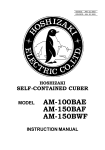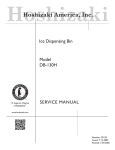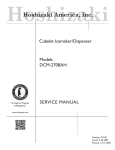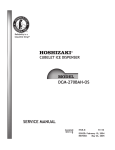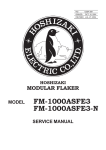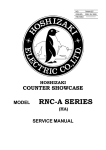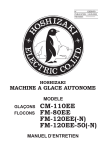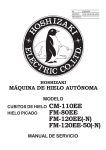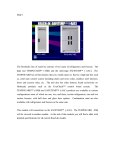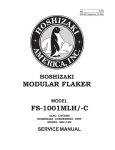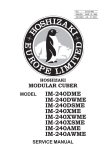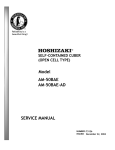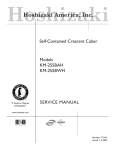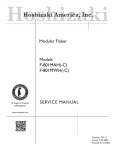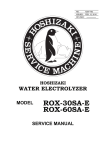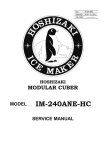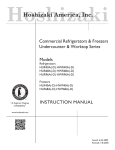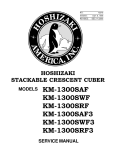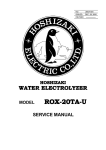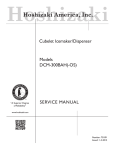Download AM-100BAE AM-150BAF AM
Transcript
NO. 17EA-622 / 73106 ISSUED: FEB. 25, 2003 REVISED: JAN. 12, 2007 HOSHIZAKI SELF-CONTAINED CUBER MODEL AM-100BAE AM-150BAF AM-150BWF SERVICE MANUAL IMPORTANT Only qualified service technicians should attempt to service or maintain this icemaker. No such service or maintenance should be undertaken until the technician has thoroughly read this Service Manual. HOSHIZAKI provides this manual primarily to assist qualified service technicians in the service and maintenance of the icemaker. Should the reader have any questions or concerns which have not been satisfactorily addressed, please call or write to the HOSHIZAKI Technical Support Department for assistance. HOSHIZAKI AMERICA, INC. 618 Highway 74 South Peachtree City, GA 30269 Attn: HOSHIZAKI Technical Support Department Phone: 1-800-233-1940 Technical Service (770) 487-2331 Fax: (770) 487-3360 NOTE: To expedite assistance, all correspondence/communication MUST include the following information: • Model Number • Serial Number • Complete and detailed explanation of the problem CONTENTS PAGE I. SPECIFICATIONS ------------------------------------------------------------------------------------1. DIMENSIONS/CONNECTIONS----------------------------------------------------------------[a] AM-100BAE -----------------------------------------------------------------------------------[b] AM-150BAF ------------------------------------------------------------------------------------[c] AM-150BWF -----------------------------------------------------------------------------------2. SPECIFICATIONS --------------------------------------------------------------------------------[a] AM-100BAE -----------------------------------------------------------------------------------[b] AM-150BAF ------------------------------------------------------------------------------------[c] AM-150BWF ------------------------------------------------------------------------------------ 1 1 1 2 3 4 4 5 6 II. GENERAL INFORMATION -------------------------------------------------------------------------- 7 1. CONSTRUCTION ---------------------------------------------------------------------------------- 7 [a] AM-100BAE ------------------------------------------------------------------------------------ 7 [b] AM-150BAF ------------------------------------------------------------------------------------- 8 [c] AM-150BWF ------------------------------------------------------------------------------------ 9 2. ICEMAKING COMPARTMENT ---------------------------------------------------------------- 10 III. INSTALLATION AND OPERATING INSTRUCTIONS ---------------------------------------- 11 1. CHECKS BEFORE INSTALLATION---------------------------------------------------------- 11 2. LOCATION ------------------------------------------------------------------------------------------ 12 3. SET UP---------------------------------------------------------------------------------------------- 13 4. ELECTRICAL CONNECTIONS ---------------------------------------------------------------- 13 5. WATER SUPPLY AND DRAIN CONNECTIONS ------------------------------------------- 14 6. FINAL CHECK LIST ------------------------------------------------------------------------------ 16 7. START UP ------------------------------------------------------------------------------------------ 16 8. PREPARING THE ICEMAKER FOR LONG STORAGE (more than 1 day) ---------- 17 IV. MAINTENANCE AND CLEANING INSTRUCTIONS ---------------------------------------- 19 1. CLEANING INSTRUCTIONS ------------------------------------------------------------------- 19 [a] WATER SYSTEM ----------------------------------------------------------------------------- 19 [b] STORAGE BIN, SLOPE, SCOOP, ETC. ------------------------------------------------ 21 2. MAINTENANCE ----------------------------------------------------------------------------------- 23 3. WATER VALVE ------------------------------------------------------------------------------------ 24 4. BIN CONTROL THERMOSTAT ---------------------------------------------------------------- 25 V. TECHNICAL INFORMATION ---------------------------------------------------------------------- 26 1. WATER CIRCUIT AND REFRIGERANT CIRCUIT ----------------------------------------- 26 [a] AM-100BAE ----------------------------------------------------------------------------------- 26 [b] AM-150BAF ------------------------------------------------------------------------------------ 27 [c] AM-150BWF ----------------------------------------------------------------------------------- 28 2. WIRING DIAGRAM ------------------------------------------------------------------------------- 29 [a] AM-100BAE ----------------------------------------------------------------------------------- 29 [b] AM-150BAF ------------------------------------------------------------------------------------ 30 [c] AM-150BWF ----------------------------------------------------------------------------------- 31 i 3. CONTROLS ---------------------------------------------------------------------------------------- 32 [a] ICEMAKING CONTROL --------------------------------------------------------------------- 32 [b] DEFROST CONTROL ----------------------------------------------------------------------- 32 [c] NO ADJUSTMENT REQUIRED ----------------------------------------------------------- 32 [d] ADJUSTMENT AT PART REPLACEMENT -------------------------------------------- 32 4. TIMING CHART ------------------------------------------------------------------------------------ 34 5. PERFORMANCE DATA------------------------------------------------------------------------- 35 [a] AM-100BAE ----------------------------------------------------------------------------------- 35 [b] AM-150BAF ------------------------------------------------------------------------------------ 36 [c] AM-150BWF ----------------------------------------------------------------------------------- 37 VI. SERVICE DIAGNOSIS ---------------------------------------------------------------------------- 38 1. NO ICE PRODUCTION -------------------------------------------------------------------------- 38 2. LOW ICE PRODUCTION ------------------------------------------------------------------------ 40 3. ABNORMAL ICE ---------------------------------------------------------------------------------- 40 4. OTHERS -------------------------------------------------------------------------------------------- 41 VII. ADJUSTMENT -------------------------------------------------------------------------------------- 42 1. EXPANSION VALVE - AM-150BAF ONLY -------------------------------------------------- 42 2. WATER REGULATING VALVE - WATER-COOLED MODEL ONLY ------------------ 43 VIII. REMOVAL AND REPLACEMENT ------------------------------------------------------------- 44 1. SERVICE FOR REFRIGERANT LINES ----------------------------------------------------- 44 [a] SERVICE INFORMATION ------------------------------------------------------------------ 44 [b] REFRIGERANT RECOVERY -------------------------------------------------------------- 45 [c] EVACUATION AND RECHARGE --------------------------------------------------------- 46 2. COMPRESSOR ----------------------------------------------------------------------------------- 47 3. DRIER ----------------------------------------------------------------------------------------------- 48 4. EVAPORATOR ------------------------------------------------------------------------------------ 49 5. HOT GAS VALVE --------------------------------------------------------------------------------- 50 6. PUMP MOTOR ------------------------------------------------------------------------------------ 51 7. FAN MOTOR --------------------------------------------------------------------------------------- 51 8. WATER VALVE ------------------------------------------------------------------------------------ 52 9. CONTROLLER BOARD ------------------------------------------------------------------------- 52 10. THERMISTOR FOR CUBE CONTROL ------------------------------------------------------ 53 11. BIN CONTROL THERMOSTAT ---------------------------------------------------------------- 54 12. EXPANSION VALVE - AM-150BAF/BWF ONLY ------------------------------------------ 55 13. WATER REGULATING VALVE - WATER-COOLED MODEL ONLY ------------------ 56 [a] VALVE BODY --------------------------------------------------------------------------------- 56 [b] WHOLE VALVE ------------------------------------------------------------------------------- 57 ii I. SPECIFICATIONS 1. DIMENSIONS/CONNECTIONS [a] AM-100BAE 1 [b] AM-150BAF 2 [c] AM-150BWF 3 2. SPECIFICATIONS [a] AM-100BAE AC SUPPLY VOLTAGE AMPERAGE MINIMUM CIRCUIT AMPACITY MAXIMUM FUSE SIZE 115/60/1 6.5A (5 Min. Freeze AT 104°F/ WT 80°F) N/A N/A APPROXIMATE ICE PRODUCTION PER 24 HR. lbs./day (kg/day) SHAPE OF ICE ICE PRODUCTION PER CYCLE APPROXIMATE STORAGE CAPACITY Ambient Water Temp. (°F) Temp. (°F) 50 70 70 105 (48) 103 (47) 80 96 (44) 93 (42) 90 86 (39) 83 (38) 100 67 (31) 66 (30) Cube ø20 x H27mm 1.54 lbs. (0.70 kg) 60 pcs. 44 Ibs. ELECTRIC & WATER CONSUMPTION ELECTRIC W (KWH/100 lbs.) WATER gal./24HR (gal./100 lbs.) 90°F/70°F 490 (15.7) 31 (38) EXTERIOR DIMENSIONS (W x D x H) EXTERIOR FINISH WEIGHT CONNECTIONS - ELECTRIC - WATER SUPPLY - DRAIN 24.9” x 20.5” x 38.7” (633 x 520 x 982mm) Includes 6” leg Stainless Steel, Galvanized Steel (Rear) Net 110 lbs. (50 kg) Shipping 150 lbs. (68 kg) Cord Connection Inlet Fitting size is a 1/2” FPT (Water Inlet 3/4” BSP) Outlet 3/4” FPT CUBE CONTROL SYSTEM HARVESTING CONTROL SYSTEM ICE MAKING WATER CONTROL COOLING WATER CONTROL BIN CONTROL SYSTEM Thermistor, Timer Hot gas, Thermistor Timer N/A Thermostat COMPRESSOR CONDENSER EVAPORATOR REFRIGERANT CONTROL REFRIGERANT CHARGE Hermetic, Model QA110K27CAU6 Air-cooled, Fin and Tube type Tin-plated copper tube on sheet and cells Capillary Tube R134a 6.6 oz. (185 g) COMPRESSOR PROTECTION Auto-reset Overload Protector ACCESSORIES - SUPPLIED - REQUIRED Ice Scoop, 6” Leg (4 pcs) N/A OPERATION CONDITIONS VOLTAGE RANGE AMBIENT TEMP. WATER SUPPLY TEMP. WATER SUPPLY PRESS. DRAWING NO. (DIMENSIONS) 3X6975 70°F/50°F 430 (9.9) 38 (37) 90 96 (43) 86 (39) 76 (35) 61 (28) See details of PERFORMANCE DATA No. SS-01129 104 - 127 V 50 - 100°F 41 - 90°F 7 - 113 PSIG * We reserve the right to make changes in specifications and design without prior notice. 4 [b] AM-150BAF AC SUPPLY VOLTAGE AMPERAGE MINIMUM CIRCUIT AMPACITY MAXIMUM FUSE SIZE 115/60/1 8.8A (5 Min. Freeze AT 104°F/ WT 80°F) N/A N/A APPROXIMATE ICE PRODUCTION PER 24 HR. lbs./day (kg/day) SHAPE OF ICE ICE PRODUCTION PER CYCLE APPROXIMATE STORAGE CAPACITY Ambient Water Temp. (°F) Temp. (°F) 50 70 90 70 150 (68) 140 (64) 130 (59) 80 140 (64) 130 (59) 120 (55) 90 130 (59) 120 (55) 110 (50) 100 110 (51) 105 (48) 100 (45) Cube ø20 x H27mm 1.87 lbs. (0.85 kg) 60 pcs. 88 Ibs. ELECTRIC & WATER CONSUMPTION ELECTRIC W (KWH/100 lbs.) WATER gal./24HR (gal./100 lbs.) 90°F/70°F 710 (14.2) 36 (31) EXTERIOR DIMENSIONS (W x D x H) EXTERIOR FINISH WEIGHT CONNECTIONS - ELECTRIC - WATER SUPPLY - DRAIN 27.7” x 28” x 38.8” (703 x 710 x 986mm) Includes 6” leg Stainless Steel, Galvanized Steel (Rear) Net 143 lbs. (65 kg) Shipping 185 lbs. (84 kg) Cord Connection Inlet Fitting size is a 1/2” FPT (Water Inlet 3/4” BSP) Outlet 3/4” FPT CUBE CONTROL SYSTEM HARVESTING CONTROL SYSTEM ICE MAKING WATER CONTROL COOLING WATER CONTROL BIN CONTROL SYSTEM Thermistor, Timer Hot gas, Thermistor Timer N/A Thermostat COMPRESSOR CONDENSER EVAPORATOR REFRIGERANT CONTROL REFRIGERANT CHARGE Hermetic, Model ASE24C3E Air-cooled, Fin and Tube type Tin-plated copper tube on sheet and cells Expansion Valve R404A 9.5 oz. (270 g) 70°F/50°F 660 (10.6) 44 (31) See details of PERFORMANCE DATA No. SS-01131 COMPRESSOR PROTECTION Auto-reset Overload Protector REFRIGERANT CIRCUIT PROTECTION Auto-reset High Pressure Control Switch ACCESSORIES - SUPPLIED - REQUIRED Ice Scoop, 6” Leg (4 pcs) N/A OPERATION CONDITIONS VOLTAGE RANGE AMBIENT TEMP. WATER SUPPLY TEMP. WATER SUPPLY PRESS. DRAWING NO. (DIMENSIONS) 3X6976 104 - 127 V 50 - 100°F 41 - 90°F 7 - 113 PSIG * We reserve the right to make changes in specifications and design without prior notice. 5 [c] AM-150BWF AC SUPPLY VOLTAGE AMPERAGE MINIMUM CIRCUIT AMPACITY MAXIMUM FUSE SIZE 115/60/1 7.0A (5 Min. Freeze AT 104°F/ WT 80°F) N/A N/A APPROXIMATE ICE PRODUCTION PER 24 HR. lbs./day (kg/day) SHAPE OF ICE ICE PRODUCTION PER CYCLE APPROXIMATE STORAGE CAPACITY Ambient Water Temp. (°F) Temp. (°F) 50 70 90 70 150 (68) 140 (64) 130 (60) 80 150 (68) 140 (64) 130 (60) 90 145 (66) 140 (64) 130 (60) 100 145 (66) 135 (62) 125 (58) Cube ø20 x H27mm 1.78 lbs. (0.81 kg) 60 pcs. 88 Ibs. ELECTRIC & WATER CONSUMPTION ELECTRIC W (KWH/100 lbs.) WATER gal./24HR (gal./100 lbs.) WATER-COOLED CONDENSER 90°F/70°F 560 (9.5) 43 (31) 196 (140) EXTERIOR DIMENSIONS (W x D x H) 27.7” x 28” x 38.8” (703 x 710 x 986mm) Includes 6” leg Stainless Steel, Galvanized Steel (Rear) Net 138 lbs. (63 kg) Shipping 180 lbs. (82 kg) Cord Connection Inlet Fitting size is a 1/2” FPT (Water Inlet 3/4” BSP) Outlet 3/4” FPT Inlet 1/2” FPT Outlet 3/8” FPT EXTERIOR FINISH WEIGHT CONNECTIONS - ELECTRIC - WATER SUPPLY - DRAIN - COOLING WATER 70°F/50°F 560 (9.0) 48 (31) 138 (92) See details of PERFORMANCE DATA No. SS-01769 CUBE CONTROL SYSTEM HARVESTING CONTROL SYSTEM ICE MAKING WATER CONTROL COOLING WATER CONTROL BIN CONTROL SYSTEM Thermistor, Timer Hot gas, Thermistor Timer N/A Thermostat COMPRESSOR CONDENSER EVAPORATOR REFRIGERANT CONTROL REFRIGERANT CHARGE Hermetic, Model ASE24C3E Water-cooled, Tube in Tube type Tin-plated copper tube on sheet and cells Expansion Valve R404A 9.5 oz. (270 g) COMPRESSOR PROTECTION Auto-reset Overload Protector REFRIGERANT CIRCUIT PROTECTION Auto-reset High Pressure Control Switch ACCESSORIES - SUPPLIED - REQUIRED Ice Scoop, 6” Leg (4 pcs) N/A OPERATION CONDITIONS VOLTAGE RANGE AMBIENT TEMP. WATER SUPPLY TEMP. WATER SUPPLY PRESS. DRAWING NO. (DIMENSIONS) 3X6976 104 - 127 V 50 - 100°F 41 - 90°F 7 - 113 PSIG * We reserve the right to make changes in specifications and design without prior notice. 6 II. GENERAL INFORMATION 1. CONSTRUCTION [a] AM-100BAE Top Panel Front Panel (Upper) Ice Making Mechanism Bin Control Thermostat Storage Bin Slope Door Front Panel (Lower) Control Box Condenser Air Filter Tapped Hole (Leg Mounting) Control Switch Fuse 7 [b] AM-150BAF Top Panel Ice Making Mechanism Separator Water Tank Bin Control Thermostat Slope Door Storage Bin Front Panel (Lower) Control Box Condenser Air Filter Tapped Hole (Leg Mounting) Control Switch Fuse 8 [c] AM-150BWF Top Panel Ice Making Mechanism Separator Water Tank Bin Control Thermostat Slope Door Storage Bin Front Panel (Lower) Control Box Condenser Tapped Hole (Leg Mounting) Control Switch Fuse 9 2. ICEMAKING COMPARTMENT Bracket Evaporator Separator Ice Chute Pump Motor Water Plate Water Tank 10 III. INSTALLATION AND OPERATING INSTRUCTIONS 1. CHECKS BEFORE INSTALLATION * Visually inspect the exterior of the shipping container, and any severe damage noted should be reported to the carrier. WARNING 1. Remove shipping tape(s) and packing as follows. If any left in the icemaker, it will not work properly. 2. Do not lift or carry the unpacked icemaker by using the brass fitting for water supply at the rear of the unit. The plastic threads may be damaged. IMPORTANT 1. Remove the shipping tapes holding the Door and Separator. 2. Ensure all components, fasteners and thumbscrews are securely in place. * Remove the package containing accessories. * Check that refrigerant lines do not rub or touch lines or other surfaces. * Check that the Compressor is snug on all mounting pads. * See the Nameplate on the upper right part of the Left Side Panel, and check that your voltage supplied corresponds with the voltage specified on the Nameplate. Ice Making Mechanism Separator Shipping Tape Nameplate Door Shipping Tape Accessories Compressor Mounting Pad Fig. 1 11 2. LOCATION WARNING This icemaker is not intended for outdoor use. Normal operating ambient temperature should be within 50°F (10°C) to 100°F (38°C); Normal operating water temperature should be within 41°F (5°C) to 90°F (32°C). Operation of the icemaker, for extended periods, outside of these normal temperature ranges may affect production capacity. For best operating results: * The icemaker should not be located next to ovens, grills or other high heat producing equipment. * The location should provide a firm foundation for the equipment. Level the icemaker from side to side and front to rear. * Avoid a site where dripping is not allowed. * This icemaker will not work at subfreezing temperatures. To prevent damage to the water supply line, drain the icemaker when air temperature is below zero. * The AM-100BAE icemaker requires no clearance at either side. But allow enough space at rear for water supply and drain connections and at least 12” (approx. 30 cm) clearance at front. * The AM-150BAF icemaker requires 2” (approx. 5 cm) clearance at either side. Allow enough space at rear for water supply and drain connections and at least 12” (approx. 30 cm) clearance at front. 12 3. SET UP IMPORTANT Do not place heavy objects exceeding 33 lbs (15 kg) on the Top Panel. 1) Unpack the icemaker, and remove all shipping cartons, tapes and packing BEFORE operating the unit. 2) Position the icemaker in a selected site. Clean the interior with soap and water and rinse thoroughly. 3) Level the icemaker in both the left-to-right and the front-torear directions (when installed with or without legs). See Fig. 2. Max. 0.4” (1 cm) Fig. 2 4) When installing the unit without legs, the perimeter where the machine touches the counter should be sealed with silicone to prevent water from leaking under the icemaker. Tapped Hole (Leg Mounting) 5) When installing the unit with legs on the bottom, use the four accessory legs adjustable from 6” (15.2 cm) to 7” (17.8 cm). Screw the legs tightly into the tapped holes in the base (see Fig. 3). Handle the icemaker carefully not to damage the exterior. Base Adjustable Leg Fig. 3 4. ELECTRICAL CONNECTIONS WARNING THIS APPLIANCE MUST BE GROUNDED. This icemaker requires a ground that meets the national and local electrical code requirements. To prevent possible severe electrical shock injury to individuals or extensive damage to equipment, install a proper ground wire to this icemaker. Remove the plug from the mains socket before any maintenance, repairs or cleaning is undertaken. * This icemaker must be plugged into the separated power receptacle which has enough capacity. The maximum allowable voltage variation should not exceed ± 10 percent of the nameplate rating. See the Nameplate. * Usually an electrical permit and services of a licensed electrician are required. 13 5. WATER SUPPLY AND DRAIN CONNECTIONS WARNING To prevent damage to the freezer mechanism, do not operate this icemaker when the water supply is OFF, or if the pressure is below 10 PSIG (0.7 bar), the recommended water pressure. Stop the icemaker until proper water pressure is resumed. CAUTION 1. A brass fitting for the water supply line connection is attached to the 3/4” BSP plastic threads to avoid cross-threading of the Water Valve possibly resulting in leaks. The brass fitting allows connection of a 1/2” FPT that should be connected to the potable water supply line. 2. While making the water supply line connection, use a wrench to hold the brass fitting still to prevent overtightening and damage to the plastic threads. * Water supply inlet for the icemaker is 1/2” female pipe thread (FPT). Note: On water-cooled model, two water supply inlets are provided. One is for the icemaker (1/2” FPT), and the other is for the water-cooled condenser (1/2” FPT). * The brass fitting is attached as shown in Fig. 4. The fitting size is a 1/2” FPT and must be connected only to a potable water supply. * A water supply line shut-off valve and drain valve must be installed. * Water supply pressure should be a minimum of 10 PSIG (0.7 bar) and a maximum of 113 PSIG (7.5 bar). If the pressure exceeds 113 PSIG (7.5 bar), use a pressure reducing valve. * Drain outlet for icemaker dump is 3/4” FPT. Note: On water-cooled model, a 3/8” FPT is provided for the condenser drain outlet. The icemaker drain and the condenser drain piping connections must be made separately. * Drain must be 1/4” fall per foot (2 cm fall per meter) on horizontal runs to get good flow. * Keep a more than 2 vertical inch (5 vertical cm) air gap between the drain pipe end and the sink. * The drain pipe must be so laid as to prevent a backflow into the Storage Bin. Provide a trap in the bin drain line to prevent odor from flowing back into the Storage Bin. 14 * A plumbing permit and services of a licensed plumber may be required in some areas. * This icemaker should be installed in accordance with applicable national, state and local regulations. AM-100BAE AM-150BAF Icemaker Water Supply Inlet 3/4” BSP Threads Brass fitting is attached to Water Supply Inlet. Fitting size is a 1/2” FPT. Shut-off Valve Drain Valve Bin Drain Outlet 3/4” FPT Trap 1/4” fall per foot To approved floor drain AM-150BWF Icemaker Water Supply Inlet 3/4” BSP Threads Condenser Outlet 3/8” FPT Brass fitting is attached to Water Supply Inlet. Fitting size is a 1/2” FPT. Water-cooled Condenser Inlet 1/2” FPT Shut-off Valve Drain Valve Bin Drain Outlet 3/4” FPT 1/4” fall per foot Drain Valve To approved floor drain Shut-off Valve Trap Fig. 4 15 6. FINAL CHECK LIST 1) Is the icemaker level? 2) Is the icemaker in a site where the ambient temperature is within 50°F (10°C) to 100°F (38°C) and the water temperature within 41°F (5°C) to 90°F (32°C) all year around? 3) Have all shipping tape(s), string and packing been removed from the icemaker? 4) Are all components, fasteners and thumbscrews securely in place? 5) Have all electrical and piping connections been made? 6) Has the power supply voltage been tested or checked against the nameplate rating? Has a proper earth been installed to the icemaker? 7) Are the Water Supply Line Shut-off Valve and Drain Valve installed? Has the water supply pressure been checked to ensure a minimum of 10 PSIG (0.7 bar) and a maximum of 113 PSIG (7.5 bar)? 8) Have the Compressor hold-down bolts and all refrigerant lines been checked against vibration and possible failure? 9) Has the Bin Control Thermostat been checked for correct operation? When the icemaker is running, cool the Detector of the Bin Control Thermostat. The icemaker should stop within 10 seconds. 10) Has the user been given the Instruction Manual and instructed on how to operate the icemaker and the importance of periodic maintenance recommended? 11) Has the user been given the name and telephone number of the Authorized Service Agency? 7. START UP * Check that shipping tape(s), string and packing are removed before starting the icemaker. 1) Clean inside the Storage Bin and Door. 2) Open the Water Supply Line Shut-off Valve and plug in the icemaker. 3) Remove the Front Panel (Lower), and move the Control Switch on the Control Box to the “ICE” position. * The freezing cycle will start automatically. 16 8. PREPARING THE ICEMAKER FOR LONG STORAGE (more than 1 day) WARNING Drain the icemaker to prevent damage to the water supply line at subfreezing temperatures, using air or carbon dioxide. Shut off the icemaker until proper air temperature is resumed. [1] On water-cooled model only, first remove the water from the water-cooled condenser: 1) Remove the Front Panel (Lower). Icemaker Potable Water Supply Line 2) Move the Control Switch, on the Control Box, to the “OFF” position. 3) Wait 3 minutes. Shut-off Valve 4) Move the Control Switch to the “ICE” position. 5) Allow 5 minutes for the icemaker to fill with water and the Water Pump to start operating. Drain Valve Air or CO2 Water-cooled Condenser Shut-off Valve 6) Close the Water-cooled Condenser Water Supply Line Water Supply Line Shut-off Valve. 7) Open the Drain Valve for the water-cooled condenser water supply line. Drain Valve Air or CO2 Fig. 5 8) Allow the line to drain by gravity. 9) Attach compressed air or carbon dioxide supply to the Condenser Water Line Drain Valve. 10) Blow the water-cooled condenser out using compressed air or carbon dioxide until water stops coming out. [2] Remove the water from the potable water supply line and the Water Tank: 1) Close the Water Supply Line Shut-off Valve, and open the Drain Valve. 2) Remove the Front Panel (Lower), and move the Control Switch, on the Control Box, to the “OFF” position. 17 3) Blow out the water supply line. Note: This procedure is necessary to protect the icemaker from freezing up at subfreezing temperature. 4) Unplug the icemaker. 5) Remove all ice from the Storage Bin, and clean the Bin. 6) Drain and clean the Water Tank. See “IV. 1. [b] STORAGE BIN, SLOPE, SCOOP, ETC.” 7) Refit the Front Panel (Lower) in its correct position. 8) Close the Drain Valve. 18 IV. MAINTENANCE AND CLEANING INSTRUCTIONS IMPORTANT Ensure all components, fasteners and thumbscrews are securely in place after any maintenance or cleaning is done to the equipment. 1. CLEANING INSTRUCTIONS WARNING 1. HOSHIZAKI recommends cleaning this unit at least once a year. More frequent cleaning, however, may be required in some existing water conditions. 2. To prevent injury to individuals and damage to the icemaker, do not use ammonia type cleaners. 3. Always wear liquid-proof gloves for safe handling of the cleaning and sanitizing solutions. This will prevent irritation in case the solution comes into contact with skin. [a] WATER SYSTEM 1) Dilute approximately 5 fl. oz. (148 ml) of recommended cleaner Hoshizaki “Scale Away” or “LIME-A-WAY” (Economics Laboratory, Inc.) with 1 gal. (3.8 lit.) of water. 2) Remove all ice from the Evaporator and the Storage Bin. Note: To remove cubes on the Evaporator, remove the Front Panel (Lower), move the Control Switch on the Control Box to the “OFF” position and move it back to the “ICE” position after 3 minutes. The defrost cycle starts and the cubes will be removed from the Evaporator. 3) Move the Control Switch to the “OFF” position. Close the Water Supply Line Shut-off Valve. 4) Remove the Water Tank to drain the water. Refit the Water Tank in its correct position. 5) Slowly pour the cleaning solution into the Water Tank. 6) Move the Control Switch to the “WASH” position. 7) After circulating the cleaning solution for about 30 minutes, move the Control Switch to the “OFF” position. 19 8) Remove the Water Tank to drain the cleaning solution. Refit the Water Tank in its correct position. 9) Open the Shut-off Valve. 10) Move the Control Switch to the “WASH” position to circulate clean water for about 5 minutes. 11) Move the Control Switch to the “OFF” position and immediately back to the “WASH” position to rinse water. 12) Repeat the above rinse procedure three more times to rinse thoroughly. 13) Dilute approximately 0.5 fl. oz. (14.8 ml) of 5.25% Sodium Hypochlorite (Chlorine Bleach) with 1 gal. (3.8 lit.) of water. 14) Move the Control Switch to the “OFF” position. Close the Water Supply Line Shut-off Valve. 15) Remove the Water Tank to drain the water. Refit the Water Tank in its correct position. 16) Slowly pour the sanitizing solution into the Water Tank. 17) Move the Control Switch to the “WASH” position. 18) After circulating the sanitizing solution for about 15 minutes, move the Control Switch to the “OFF” position. 19) Remove the Water Tank to drain the sanitizing solution. Refit the Water Tank in its correct position. 20) Open the Shut-off Valve. 21) Move the Control Switch to the “WASH” position to circulate clean water for about 5 minutes. 22) Move the Control Switch to the “OFF” position and immediately back to the “WASH” position to rinse water. 23) Repeat the above rinse procedure two more times to rinse thoroughly. 24) Move the Control Switch to the “ICE” position, and start the automatic icemaking process. Refit the Front Panel (Lower) in its correct position. 20 [b] STORAGE BIN, SLOPE, SCOOP, ETC. IMPORTANT 1. Wash your hands before removing ice. Use the Plastic Scoop provided to remove ice. 2. Keep the Scoop clean. Clean it by using a neutral cleaner at least once a day, and rinse thoroughly. 3. Close the Bin Door after removing ice to prevent entrance of dirt, dust or insects into the Bin. 4. Clean the Bin Liner at least once a month by using a neutral cleaner. Rinse thoroughly after cleaning. 5. The Storage Bin is for ice use only. Do not store anything else in the Bin. 6. Keep the area around the icemaker clean. Dirt, dust or insects in the icemaker could cause electrical damage to the equipment or harm to individuals. 1) Remove the Front Panel (Lower), and move the Control Switch on the Control Box to the “OFF” position. 2) Unplug the icemaker. 3) Open the Bin Door, and remove ice from the Storage Bin. 4) Remove the Slope by bending its center carefully and releasing it from the two Slope Shafts. Take out the Slope from the Storage Bin. 5) Thoroughly clean and sanitize the Storage Bin, Slope, Scoop and any parts normally accessible from the Storage Bin. 6) Remove each Separator by lifting it to the horizontal position and pushing it hard inward. Remove all the Separators in the same way, and clean and sanitize them. Separator 7) Disconnect the Suction Tube from the Water Tank to drain the Tank. Water Tank Suction Tube 21 8) Remove the Thumbscrews on both sides of the Water Tank, and pull it out toward you. Clean and sanitize the Water Tank. Water Tank Thumbscrew 9) Pull the Discharge Tube from the Water Plate. Remove the Water Plate by pulling it toward you. Water Plate Discharge Tube 10) Remove the Caps to clean and sanitize the Water Plate. If the Nozzles are clogged, clean them with a wire or a suitable brush. Cap Water Plate 11) Refit the Caps on the Cleaning Outlets to seal them off. Cap Water Plate Water Plate 12) Slide in the Water Plate along the Mechanism Base. Refit the Discharge Tube securely on the Spray Outlet. A loose fitting may cause a water leak. Discharge Tube 13) Place the rear of the Water Tank on the Water Tank Rest at the back of the Storage Bin. Use the Thumbscrews to secure the front of the Water Tank to the Mechanism Base. Mechanism Base Bin Rear Tank Rest Thumbscrew Water Tank 14) Refit the Suction Tube on to the Water Tank Inlet. A loose fitting may cause a water leak. Water Tank Suction Tube 22 15) Hook each Separator on to the Mechanism Base, and pull it hard toward you until it locks in place with a click. Refit all the Separators in the same way. Separator 16) Refit the Slope in its correct position. 17) Plug in the icemaker, and move the Control Switch on the Control Box to the “ICE” position to start the automatic icemaking process. 18) Refit the Front Panel (Lower) in its correct position. 2. MAINTENANCE IMPORTANT This icemaker must be maintained individually, referring to the instruction manual and labels provided with the icemaker. 1) Exterior To keep the exterior clean, wipe occasionally with a clean and soft cloth. Use a damp cloth containing a neutral cleaner to wipe off all oil or dirt build-up. 2) Air Filter A plastic mesh air filter removes dirt or dust from the air, and keeps the Condenser from getting clogged. As the filter gets clogged, the icemaker’s performance will be reduced. Check the filter at least twice a month. When clogged, use warm water and a neutral cleaner to wash the filter. 3) Condenser Check the Condenser once a year, and clean if required by using a brush or vacuum cleaner. More frequent cleaning may be required depending on the location of the icemaker. 23 3. WATER VALVE 1) Unplug the icemaker or disconnect the power source. 2) Close the water supply tap. 3) Remove the Top Panel and Door. 4) Disconnect the Water Supply Inlet from the Water Valve. 5) Remove the Mesh Filter from the Water Valve. 6) Clean the Mesh using a brush. 7) Refit the Mesh and Water Supply Inlet in their correct positions. 8) Open the water supply tap. 9) Plug in the icemaker or connect the power source. 10) Check for leaks. 11) Refit the panels in their correct positions. Coil Filter Do not remove Fig. 6 24 4. BIN CONTROL THERMOSTAT Bin Control Thermostat Replacement Procedure To ensure proper operation, follow the instructions below: 1) Make a 40 mm (1.6”) diameter loop. 2) Locate the loop below the Thermostat Capillary (Bulb). 3) Manually bend the Capillary to keep it 15 mm (0.6”) forward from the through hole position on the Holder. 4) Turn up the end of the Capillary. Holder Through Hole Capillary (Bulb) End Loop 15 mm (0.6”) Capillary (Bulb) 40 mm (1.6”) DIA Bin Control Thermostat Assembly Details Thermostat A 150mm (5.9”) Silicone Tube 210mm (8.3”) Silicone Tube Seal Cord Heate Flexible Tube Capillary (Bulb) DETAIL A [NOTE] 1) Run Cord Heater along with Capillary of Thermostat and bind them tightly with Aluminum Tape (Form end to end of Cord Heater). 2) Do not overheat Flexible Tube during shrinking process. 25 V. TECHNICAL INFORMATION 1. WATER CIRCUIT AND REFRIGERANT CIRCUIT [a] AM-100BAE Water Inlet Capillary Tube Accumulator Evaporator Water Plate Drain Pan Insulation Pump Motor Insulation Water Tank Bin Controller Board Drier Condenser Fan Compressor Water Circuit Refrigeration Circuit 26 Hot Gas Valve [b] AM-150BAF Water Inlet Expansion Valve Bulb Evaporator Water Plate Water Tank Pump Motor Drain Pan Bin Controller Board Hot Gas Valve Compressor Pressure Switch Fan Drier Condenser Water Circuit Refrigeration Circuit 27 [c] AM-150BWF Water Inlet Expansion Valve Bulb Evaporator Water Plate Water Tank Pump Motor Drain Pan Bin Controller Board Hot Gas Valve Compressor Pressure Switch Drier Condenser Water Regulator Water Circuit Refrigeration Circuit 28 2. WIRING DIAGRAM [a] AM-100BAE 29 [b] AM-150BAF 30 [c] AM-150BWF 31 3. CONTROLS [a] ICEMAKING CONTROL The freeze and defrost cycles are controlled by the combination of a Thermistor and an Electronic Controller. When the Evaporator cools down to a specific temperature (around 27°F), the Thermistor attached to the Evaporator senses the temperature and signals to the Electronic Controller. After the built-in Timer counts 8 minutes from the signal input, the Controller switches the contact of the built-in Relays (X1 and X2) to stop the Pump Motor and Fan Motor and to open the Hot Gas Valve and Water Valve. This completes the freeze cycle and starts the defrost cycle. [b] DEFROST CONTROL The ice cubes formed inside the Icemaking Cells are released by hot gas warming the Evaporator. When a small portion of the ice melts on the Icemaking Cell interior, the ice drops by its own weight and slides down the Ice Guide into the Storage Bin. When the Evaporator is warmed further (to around 45°F), the Thermistor senses the temperature rise and signals to the Electronic Controller. After the built-in Timer counts 50 seconds from the signal input, the Controller switches the contact of the built-in Relays to start the Pump Motor and Fan Motor and to close the Hot Gas Valve and Water Valve. This completes the defrost cycle and starts the freeze cycle. At low temperature conditions where the defrost cycle exceeds 102 seconds, the Water Valve will close after 102 seconds. In the initial cycle at startup or after shutdown for bin control, water is supplied for 102 seconds. This means the Water Valve closes (approx. 50 seconds) after the freeze cycle starts. [c] NO ADJUSTMENT REQUIRED The Thermistor and Electronic Controller are factory adjusted to produce constant ice all the year around, not affected by changes in the ambient and water temperatures. No adjustment is required for any ambient temperature. [d] ADJUSTMENT AT PART REPLACEMENT Electronic Controller The Thermistor and Electronic Controller are designed for optimum ice production. If adjustment is desired, follow the instructions below. Variable Resistor for adjustment of freeze cycle completion temperature Fig. 7 32 Variable Resistor for adjustment of defrost cycle completion temperature The Variable Resistor VR1 is for a fine adjustment of the defrost cycle completion temperature. The Variable Resistor VR2 is for a fine adjustment of the freeze cycle completion temperature. Turn VR2 clockwise for a higher temperature (WARM), i.e. ice cubes with larger diameter holes and counterclockwise for a lower temperature (COLD), i.e. ice cubes with smaller diameter holes. Note: Do not adjust VR2 to the lowest temperature. It will cause excessive ice production resulting in defrost failure. When replacing the Controller Board, turn the Variable Resistor VR1 by 90° clockwise, and leave VR2 as it is. See Fig. 8. Marking (RED) Variable Resistor for adjustment of freeze cycle completion temperature Variable Resistor for adjustment of defrost cycle completion temperature Fig. 8 33 ON OFF 34 ON OFF X2 0°C ON OFF ON OFF X1 Thermostat (Evap. Temp.) Electronic Controller Bin Control Thermostat OPEN CLOSE Hot Gas Valve ON OFF Pump Motor OPEN CLOSE ON OFF Fan Motor Water Valve ON OFF Compressor Bin Control ON Thermostat Heate OFF Power Cord Power Switch 102sec 50sec 102sec Defrost Cycle Freeze Cycle (20 - 30 min.) MAX 102sec Defrost Cycle (2 - 4 min.) ON TIME: MAX 102sec Freeze Cycle (MAX STORAGE) Shutdown (Bin Control) 102sec 50sec 102sec Defrost Freeze Cycle Cycle 4. TIMING CHART 5. PERFORMANCE DATA [a] AM-100BAE APPROXIMATE ICE PRODUCTION PER 24 HR. lbs./day (kg/day) APPROXIMATE ELECTRIC CONSUMPTION Watts APPROXIMATE WATER CONSUMPTION PER 24 HR. gal./day (m3/day) FREEZING CYCLE TIME min. HARVEST CYCLE TIME min. HEAD PRESSURE PSIG (kg/cm2G) SUCTION PRESSURE PSIG (kg/cm2G) TOTAL HEAT OF REJECTION Ambient Water Temp. (°F) Temp. (°F) 50 70 90 70 105 (48) 103 (47) 96 (44) 80 96 (44) 93 (42) 86 (39) 90 86 (39) 83 (38) 76 (35) 100 67 (31) 66 (30) 61 (28) 70 430 440 450 80 460 470 480 90 490 490 500 100 510 510 520 70 38 (0.15) 36 (0.14) 35 (0.14) 80 36 (0.14) 35 (0.14) 33 (0.13) 90 32 (0.13) 31 (0.12) 30 (0.12) 100 28 (0.11) 27 (0.11) 26 (0.10) 70 17 18 19 80 19 20 21 90 22 23 24 100 26.5 27.5 28.5 70 4 4 4 80 3 3 3 90 3 3 3 100 2.5 2.5 2.5 70 125 (0.86) 128 (0.88) 129 (0.89) 80 155 (1.07) 156 (1.08) 158 (1.09) 90 177 (1.22) 178 (1.23) 180 (1.24) 100 216 (1.49) 217 (1.50) 220 (1.52) 70 16 (0.11) 17 (0.12) 20 (0.14) 80 19 (0.13) 20 (0.14) 23 (0.16) 90 20 (0.14) 22 (0.15) 25 (0.17) 100 25 (0.17) 26 (0.18) 29 (0.20) 2400 BTU/h (AT 90°F /WT 70°F) Note: The data without *marks should be used for reference. 35 [b] AM-150BAF APPROXIMATE ICE PRODUCTION PER 24 HR. lbs./day (kg/day) APPROXIMATE ELECTRIC CONSUMPTION Watts APPROXIMATE WATER CONSUMPTION PER 24 HR. gal./day (m3/day) FREEZING CYCLE TIME min. HARVEST CYCLE TIME min. HEAD PRESSURE PSIG (kg/cm2G) SUCTION PRESSURE PSIG (kg/cm2G) TOTAL HEAT OF REJECTION Ambient Water Temp. (°F) Temp. (°F) 50 70 90 70 150 (68) 140 (64) 130 (59) 80 140 (64) 130 (59) 120 (55) 90 130 (59) 120 (55) 110 (50) 100 110 (51) 105 (48) 100 (45) 70 660 670 690 80 670 690 710 90 680 710 730 100 700 720 750 70 44 (0.17) 46 (0.16) 43 (0.15) 80 43 (0.16) 43 (0.15) 36 (0.14) 90 40 (0.15) 36 (0.14) 34 (0.13) 100 36 (0.14) 34 (0.13) 30 (0.12) 70 14 15 16 80 15.5 17.5 18 90 17 18.5 19.5 100 17.5 19 20 70 3.8 3.8 3.8 80 3 3 3 90 2.5 2.5 2.5 100 2 2 2 70 240 (1.65) 243 (1.67) 244 (1.68) 80 269 (1.85) 270 (1.86) 273 (1.88) 90 299 (2.06) 301 (2.07) 303 (2.08) 100 339 (2.33) 340 (2.34) 342 (2.35) 70 58 (0.40) 58 (0.40) 58 (0.40) 80 59 (0.41) 59 (0.41) 59 (0.41) 90 61 (0.42) 61 (0.42) 61 (0.42) 100 62 (0.43) 62 (0.43) 62 (0.43) 2460 BTU/h (AT 90°F /WT 70°F) Note: The data without *marks should be used for reference. 36 [c] AM-150BWF APPROXIMATE ICE PRODUCTION PER 24 HR. lbs./day (kg/day) APPROXIMATE ELECTRIC CONSUMPTION Watts APPROXIMATE WATER CONSUMPTION PER 24 HR. gal./day (m3/day) FREEZING CYCLE TIME min. HARVEST CYCLE TIME min. HEAD PRESSURE PSIG (kg/cm2G) SUCTION PRESSURE PSIG (kg/cm2G) TOTAL HEAT OF REJECTION Ambient Water Temp. (°F) Temp. (°F) 50 70 90 70 150 (68) 140 (64) 130 (60) 80 150 (68) 140 (64) 130 (60) 90 145 (66) 140 (64) 130 (60) 100 145 (66) 135 (62) 125 (58) 70 560 560 560 80 560 560 570 90 560 560 570 100 560 570 570 70 186 (0.70) 225 (0.85) 524 (1.98) 80 186 (0.70) 234 (0.89) 550 (2.08) 90 188 (0.71) 239 (0.90) 587 (2.22) 100 190 (0.72) 246 (0.93) 610 (2.31) 70 14 15 16.5 80 14.5 15 16.5 90 15 15 16.5 100 15 15.5 17 70 3 3 2.5 80 3 2.5 2.5 90 2.5 2.5 2.5 100 2.5 2.5 2.5 70 266 (1.84) 270 (1.86) 274 (1.89) 80 268 (1.85) 270 (1.86) 274 (1.89) 90 270 (1.86) 271 (1.87) 274 (1.89) 100 270 (1.86) 271 (1.87) 274 (1.89) 70 65 (0.45) 64 (0.44) 64 (0.44) 80 67 (0.46) 65 (0.45) 65 (0.45) 90 67 (0.46) 67 (0.46) 65 (0.45) 100 67 (0.46) 65 (0.45) 65 (0.45) 2720 BTU/h (AT 90°F /WT 70°F) Note: The data without *marks should be used for reference. 37 VI. SERVICE DIAGNOSIS 1. NO ICE PRODUCTION PROBLEM [1] The icemaker will not start. CHECK a) Control Switch POSSIBLE CAUSE 1. OFF position. 2. Loose connections. 3. Bad contacts. b) Power Cord 1. Loose connection. 2. Open circuit - damaged. 1. Blown out. 1. Tripped with Bin filled with ice. 2. Fused contacts. c) Fuse d) Bin Control Thermostat e) High Pressure Control (150BAF/BWF) f) Wiring to Controller Board g) Thermistor h) Hot Gas Solenoid Valve i) Water Supply Line (water-cooled) j) Water Solenoid Valve [2] Compressor will not start, or operates intermittently. k) Controller Board a) High Pressure Control (150BAF/BWF) b) Water Regulator (water-cooled) c) Overload Protector 1. Bad contacts. 1. Loose connections or open. 1. Leads short-circuit. 1. Continues to open in freeze cycle. 1. Water supply OFF and water supply cycle does not finish. 2. Condenser water pressure too low or OFF and Pressure Control opens and closes frequently. 1. Mesh filter or orifice gets clogged and water supply cycle does not finish. 2. Coil winding opened. 3. Wiring to Water Valve. 1. Defective. 1. Condenser water temperature too warm (water-cooled). 2. Refrigerant overcharged. 3. Condenser water pressure too low or OFF (water-cooled). 1. Set too high. 2. Clogged or defective. 1. Bad contacts. 2. Voltage too low. 38 REMEDY 1. Move to ICE position. 2. Tighten. 3. Check for continuity and replace. 1. Tighten. 2. Repair or replace. 1. Replace. 1. Remove ice. 2. Check for continuity and replace. 1. Check for continuity and replace. 1. Check for continuity and repair or replace. 1. Replace. 1. Check for power OFF in freeze cycle and replace. 1. Check for recommended pressure. 2. Check for recommended pressure. 1. Clean. 2. Replace. 3. Check for loose connection or open, and replace. 1. Replace. 1. Check for recommended temperature. 2. Recharge. 3. Check for recommended pressure. 1. Adjust lower. 2. Clean or replace. 1. Check for continuity and replace. 2. Check for recommended voltage. PROBLEM [2] (Continued) CHECK d) Starter e) Start Capacitor f) Power Relay (150BAF/BWF) g) Compressor h) Air Filter, Condenser a) Control Circuit [3] Compressor runs, but other components will not start. [4] Fan Motor will a) Wiring not run. b) Thermistor, Controller Board [5] Water a) Water Solenoid continues to be Valve supplied in b) Controller Board freeze cycle. [6] Water does not a) Water Supply Line circulate. b) Water Solenoid Valve c) Water System d) Pump Motor e) Controller Board f) Discharge Tube [7] All components run, but no ice is produced. a) Refrigerant POSSIBLE CAUSE 3. Refrigerant overcharged or undercharged. 1. Defective. 1. Defective. 1. Bad contacts. 2. Coil winding opened. 1. Wiring to Compressor. 2. Defective. 1. Clogged. 1. Replace. 1. Replace. 1. Check for continuity and replace. 2. Replace. 1. Check for loose connection or open, and repair or replace. 2. Replace. 1. Clean. 1. Loose connection or broken wire. 1. Repair or replace. 1. Loose connection or broken wire. 1. Defective. 1. Repair or replace. 1. Diaphragm does not close. 1. Defective. 1. Check for water leaks with icemaker OFF. 1. Replace. 1. Water pressure too low and water level in Water Tank too low. 1. Dirty mesh filter or orifice and water level in Water Tank too low. 1. Water leaks. 1. Check for recommended pressure. 2. Clogged. 1. Motor winding opened. 2. Bearing worn out. 3. Wiring to Pump Motor. 4. Defective or bound impeller. 1. Defective. 1. Clogged. 2. Out of position. 1. Undercharged. 2. Air or moisture trapped. b) Compressor c) Hot Gas Solenoid Valve d) Expansion Valve (150BAF/BWF) REMEDY 3. Recharge. 1. Defective valve. 1. Continues to open in freeze cycle. 1. Continues to close in freeze cycle. 39 1. Replace. 1. Clean. 1. Check connections for water leaks, and repair. 2. Clean. 1. Replace. 2. Replace. 3. Check for loose connection or open, and replace. 4. Replace and clean. 1. Replace. 1. Clean. 2. Place in position. 1. Check for leaks and recharge. 2. Replace Drier, and recharge. 1. Replace Compressor. 1. Check and replace. 1. Check and replace. 2. LOW ICE PRODUCTION PROBLEM [1] Freeze cycle time is too long. CHECK a) Water Supply b) Water Temperature c) Water Quality d) Refrigerant Charge e) Refrigerant Circuit f) Thermistor, Controller Board g) Air Filter, Condenser POSSIBLE CAUSE 1. Low pressure. REMEDY 1. Check for recommended pressure. 1. Too high. 1. Check for recommended water temperature. 1. High hardness or contains 1. Install a water filter or impurities. scale treatment. 2. Lime is deposited inside 2. Clean. Cooling Water Tubing. 1. Overcharged or 1. Recharge correctly and undercharged. check for leaks. 1. Excessive moisture. 1. Replace Drier and recharge correctly. 1. Defective. 1. Replace. 1. Clogged. 1. Clean. 3. ABNORMAL ICE PROBLEM [1] Large-hole cubes. [2] Cloudy cubes. CHECK POSSIBLE CAUSE a) Water Supply Line 1. Low pressure. b) Ambient or Water Temperature c) Air Filter, Condenser d) Water Valve e) Pump Motor f) Refrigerant Charge g) Thermistor, Controller Board h) Expansion Valve (150BAF/BWF) a) Water Supply Line b) Water Quality c) Water Valve d) Water System e) Water Plate f) Pump Motor g) Thermistor, Controller Board 1. Too high. 1. Clogged. 1. Clogged. 1. Leaks. 1. Undercharged. REMEDY 1. Check for recommended pressure. 1. Check for recommended temperatures. 1. Clean. 1. Defective. 1. Clean. 1. Repair or replace. 1. Check for leaks and recharge correctly. 1. Replace. 1. Poorly adjusted. 1. Readjust. 1. Low pressure. 1. Check for recommended pressure. 2. Clogged. 2. Check Strainer and clean. 1. High hardness or contains 1. Install a water filter or impurities. scale treatment. 2. Lime is deposited inside 2. Clean. Cooling Water Tubing. 1. Clogged. 1. Clean. 1. Scaled up. 1. Clean or remove scale. 1. Jet hole clogged. 1. Clean. 1. Leaks. 1. Replace. 2. Bearings worn out. 2. Replace. 1. Defective. 1. Replace. 40 4. OTHERS PROBLEM [1] Icemaker will not stop when Bin is filled with ice. [2] Abnormal noise CHECK a) Bin Control Thermostat b) Controller Board POSSIBLE CAUSE 1. Fused contacts. a) Pump Motor b) Fan Motor 1. Bearing worn out. 1. Bearings worn out. 2. Fan Blade deformed. 3. Fan Blade does not move freely. 1. Mounting pad out of position. 1. Rubbing or touching on other surfaces. 1. Plugged. c) Compressor d) Refrigerant Lines [3] Ice in Storage Bin often melts. a) Bin Drain 1. Defective. 41 REMEDY 1. Check for continuity and replace. 1. Replace. 1. Replace. 1. Replace. 2. Replace Fan Blade. 3. Replace. 1. Reinstall. 1. Secure or reset pipes. 1. Clean. VII. ADJUSTMENT 1. EXPANSION VALVE - AM-150BAF/BWF ONLY The Expansion Valve is factory-adjusted. Do not adjust it except at replacement or service. Adjust the valve setting, if necessary, as follows: 1) Remove the Cap Nut. 2) Use a flat-blade screwdriver to rotate the Adjust Screw. 3) Watch holes of ice cubes produced. Standard setting is that Evaporator inlet side and outlet side cubes have almost the same diameters. To make the inlet side larger, rotate 90 - 180° clockwise. Smaller, counterclockwise. Do not rotate more than 180° at a time. CAUTION Over adjustment of the valve may result in liquid refrigerant return causing freezing to the suction line and severe damage to the Compressor. Bulb Adjust Screw Capillary Tube Cap Nut Solder Connection Fig. 9 42 2. WATER REGULATING VALVE - WATER-COOLED MODEL ONLY The Water Regulating Valve is factory-adjusted. Do not adjust it except at replacement or service. Adjust the valve setting, if necessary, as follows: 1) Attach a pressure gauge to high-side line, or prepare a thermometer to check Condenser drain temperature. 2) Rotate the Adjust Screw using a flat blade screwdriver so that the pressure gauge shows 270 PSIG, or the thermometer reads 104 - 115°F, 5 minutes after Freeze Cycle starts. When the pressure or temperature exceeds the above, rotate the Adjust Screw counterclockwise. 3) Check that the pressure or temperature holds. Adjust Screw Adjust Screw Valve Body Top View 3/8-18NPT Bellows Capillary Tube Fig. 10 43 VIII. REMOVAL AND REPLACEMENT 1. SERVICE FOR REFRIGERANT LINES [a] SERVICE INFORMATION 1) Allowable Compressor Opening Time and Prevention of Lubricant Mixture [R134a/ R404A] The compressor must not be opened more than 30 minutes in replacement or service. Do not mix lubricants of different compressors even if both are charged with the same refrigerant, except when they use the same lubricant. 2) Treatment for Refrigerant Leak [R134a/R404A] If a refrigerant leak occurs in the low side of an ice maker, air may be drawn in. Even if the low side pressure is higher than the atmospheric pressure in normal operation, a continuous refrigerant leak will eventually lower the low side pressure below the atmospheric pressure and will cause air suction. Air contains a large amount of moisture, and ester oil easily absorbs a lot of moisture. If an ice maker charged with R134a/R404A has possibly drawn in air, the drier must be replaced. Be sure to use a drier designed for R134a/R404A. 3) Handling of Handy Flux [R134a/R404A] Repair of the refrigerant circuit needs brazing. It is no problem to use the same handy flux that has been used for the current refrigerants. However, its entrance into the refrigerant circuit should be avoided as much as possible. 4) Oil for Processing of Copper Tubing [R134a/R404A] When processing the copper tubing for service, wipe off oil, if any used, by using alcohol or the like. Do not use too much oil or let it into the tubing, as wax contained in the oil will clog the capillary tubing. 5) Service Parts for R134a/R404A Some parts used for refrigerants other than R134a/R404A are similar to those for R134a/ R404A. But never use any parts unless they are specified for R134a/R404A because their endurance against the refrigerant have not been evaluated. Also, for R134a/R404A, do not use any parts that have been used for other refrigerants. Otherwise, wax and chlorine remaining on the parts may adversely affect R134a/R404A. 6) Replacement Copper Tubing [R134a/R404A] The copper tubes currently in use are suitable for R134a/R404A. But do not use them if oily inside. The residual oil in copper tubes should be as little as possible. (Low residual oil type copper tubes are used in the shipped units.) 44 7) Evacuation, Vacuum Pump and Refrigerant Charge [R134a/R404A] Never allow the oil in the vacuum pump to flow backward. The vacuum level and vacuum pump may be the same as those for the current refrigerants. However, the rubber hose and gauge manifold to be used for evacuation and refrigerant charge should be exclusively for R134a/R404A. 8) Refrigerant Leak Check Refrigerant leaks can be detected by charging the unit with a little refrigerant, raising the pressure with nitrogen and using an electronic detector. Do not use air or oxygen instead of nitrogen for this purpose, or rise in pressure as well as in temperature may cause R134a or R404A to suddenly react with oxygen and explode. Be sure to use nitrogen to prevent explosion. [b] REFRIGERANT RECOVERY The refrigerant must be recovered if required by an applicable law. No refrigerant Access Valve is provided in the unit. Install a proper Access Valve on the low-side line (ex. Compressor Process Pipe). Recover the refrigerant from the Access Valve, and store it in a proper container. Do not discharge the refrigerant into the atmosphere. When replacing the Drier, take the opportunity to also fit a High-side Access Valve for ease of charging liquid refrigerant. 45 [c] EVACUATION AND RECHARGE 1) Attach Charging Hoses, a Service Manifold and a Vacuum Pump to the system. If possible, use Quick Release Connectors onto the Access Valves (especially on the high side). 2) Turn on the Vacuum Pump. 3) Allow the Vacuum Pump to pull down to a 29.9”Hg vacuum. Evacuating period depends on the pump capacity. 4) Close the Low-side and High-side Valves on the Service Manifold. 5) Disconnect the Vacuum Pump, and attach a Refrigerant Charging Cylinder to accurately weigh in the liquid charge. Remember to purge any air from the Charging Hose. See the Nameplate for the required refrigerant charge. 6) Open the High-side Valve on the Gauge Manifold, and accurately measure in the liquid charge. Close the valve on the Charging Cylinder before closing the High-side Manifold Valve. Any remaining liquid in the line can be charged into the low side. Note: Always charge in the liquid stage, as many refrigerants are blends and vapour charging will affect the blend consistency (eg. R404A). 7) Turn on the icemaker. Release the High-side Access Connector, and allow pressure in the charging line to slowly enter the low side of the system. Cap off the High-side Access Valve. When pressure reduces on the low side, disconnect the low side charging line and cap off the Access Valve. 8) Always cap the Access Valves to prevent a refrigerant leak. 9) Always thoroughly leak test all joints and valve caps. 10) Avoid charging large quantities of liquid into the low side in case of damage to the Compressor. Depressed Cap Access Valve OPEN Fig. 11 46 2. COMPRESSOR 1) Unplug the icemaker or disconnect the power source. 2) Remove the Rear Mesh and Front Panel.. 3) Recover the refrigerant and store it in a proper container, if required by an applicable law (See “1. [b] REFRIGERANT RECOVERY”). 4) Remove the Terminal Cover on the Compressor, and disconnect Solderless Terminals. 5) Disconnect the Discharge and Suction Pipes using brazing equipment. 6) Remove the Hold-down Bolts, Washers and Rubber Grommets. 7) Slide and remove the Compressor. Unpack the new Compressor package. 8) Attach the Rubber Grommets of the previous Compressor. 9) Clean the Suction and Discharge Pipes with an abrasive cloth/paper. 10) Place the Compressor in position, and secure it using the Bolts and Washers. 11) Remove Plugs from the Compressor Suction and Discharge Pipes. 12) Braze or solder the Access, Suction and Discharge lines (Do not change this order), with nitrogen gas flowing at a pressure of 3 - 4 PSIG. 13) Install the new Drier (See “3. DRIER”). 14) Check for leaks using nitrogen gas (140 PSIG) and soap bubbles. 15) Evacuate the system and charge it with refrigerant (See “1. [c] EVACUATION AND RECHARGE”). 16) Connect the Solderless Terminals and replace the Terminal Cover in its correct position. 17) Refit the panels in their correct positions. 18) Plug in the icemaker or connect the power source. Note: Hoshizaki recommends that Compressor starting electrics are always replaced at the same time as the Compressor. 47 3. DRIER 1) Unplug the icemaker or disconnect the power source. 2) Remove the Rear Mesh and Front Panel. 3) Recover the refrigerant and store it in a proper container, if required by an applicable law (See “1. [b] REFRIGERANT RECOVERY”). 4) Remove the Drier Holder, if any, and pull the Drier toward you for easy service. 5) Remove the Drier using brazing equipment. 6) Braze or solder the new Drier, with the arrow on the Drier in the direction of the refrigerant flow. Use nitrogen gas at a pressure of 3 - 4 PSIG when brazing tubings. Braze in an Access Valve using a tee if necessary. 7) Check for leaks using nitrogen gas (140 PSIG) and soap bubbles. 8) Evacuate the system and charge it with refrigerant (See “1. [c] EVACUATION AND RECHARGE”). 9) Refit the panels in their correct positions. 10) Plug in the icemaker or connect the power source. Note: Always use a Drier of the correct capacity and refrigerant type. 48 4. EVAPORATOR IMPORTANT Always install a new Drier every time the sealed refrigeration system is opened. Do not replace the Drier until after all other repair or replacement has been made. 1) Unplug the icemaker or disconnect the power source. 2) Remove the Rear Mesh, Door, Top and Front Panels. 3) Recover the refrigerant and store it in a proper container, if required by an applicable law (See “1. [b] REFRIGERANT RECOVERY”). 4) Remove the Water Tank and Water Plate, referring to “IV. 1. CLEANING.” 5) Remove the Thermistor Holder and Thermistor from the Evaporator. 6) Disconnect the solder connections on the Evaporator using brazing equipment. Protect the surrounding components from heat damage. 7) Remove the four screws holding the Evaporator. 8) Install the new Evaporator, and secure it with the four original screws. 9) Remove and replace the Drier (See “3. DRIER”). 10) Braze pipes, with nitrogen gas flowing at a pressure of 3 - 4 PSIG. 11) Check for leaks using nitrogen gas (140 PSIG) and soap bubbles. 12) Refit the Thermistor (See “10. THERMISTOR FOR CUBE CONTROL”). 13) Evacuate the system and charge it with refrigerant (See “1. [c] EVACUATION AND RECHARGE”). 14) Refit the panels in their correct positions. 15) Plug in the icemaker or connect the power source. 49 5. HOT GAS VALVE IMPORTANT Always install a new Drier every time the sealed refrigeration system is opened. Do not replace the Drier until after all other repair or replacement has been made. 1) Unplug the icemaker or disconnect the power source. 2) Remove the Rear Mesh and Front Panel. 3) Recover the refrigerant and store it in a proper container, if required by an applicable law (See “1. [b] REFRIGERANT RECOVERY”). 4) Disconnect the Hot Gas Valve leads. 5) Remove the screw and the Solenoid Coil. 6) Remove the valve and Drier using brazing equipment. 7) Braze the new Hot Gas Valve with nitrogen gas flowing at a pressure of 3 - 4 PSIG. WARNING Always protect the valve body by using a damp cloth to prevent the valve from overheating. Do not braze with the valve body exceeding 248°F. 8) Install the new Drier (See “3. DRIER”). 9) Check for leaks using nitrogen gas (140 PSIG) and soap bubbles. 10) Evacuate the system and charge it with refrigerant (See “1. [c] EVACUATION AND RECHARGE”). 11) Attach the Solenoid Coil to the valve body, and secure it with the screw. 12) Connect the leads. 13) Refit the panels in their correct positions. 14) Plug in the icemaker or connect the power source. 50 6. PUMP MOTOR 1) Unplug the icemaker or disconnect the power source. 2) Remove the Top Panel, Door and Front Panel. 3) Disconnect the Pump Motor leads behind the Evaporator. 4) Drain the Water Tank by compressing the plastic tabs on the Suction Tube to release the Joint. 5) Spread the tabs on both sides of the Water Tank and pull it toward you. 6) Carefully remove the plastic housing by releasing the retaining screws. 7) Disconnect the Pump Suction and Discharge Tubings. 8) Release the pump retaining screws to remove the Pump. 9) Install the new motor in the reverse order of the removal procedure. 10) Plug in the icemaker or connect the power source, and check for leaks. 11) Refit the panels in their correct positions. 7. FAN MOTOR 1) Unplug the icemaker or disconnect the power source. 2) Remove the Front Panel. 3) Disconnect the Connector of the Fan Motor. 4) Remove the Fan Motor Bracket and the Fan Motor. 5) Cut the leads of the Fan Motor allowing enough lead length to reconnect using closed end connectors. 6) Install the new Fan Motor in the reverse order of the removal procedure. 7) Refit the panels in their correct positions. 9) Plug in the icemaker or connect the power source. 51 8. WATER VALVE 1) Close the water supply tap. 2) Unplug the icemaker or disconnect the power source. 3) Remove the Top Panel and Front Panel. 4) Disconnect the Receptacle (leads) from the Water Valve. 5) Remove the Valve Outlet tubing. 6) Remove the Water Supply Inlet and Water Valve by releasing the two retaining screws. 7) Install the new valve in the reverse order of the removal procedure. 8) Open the water supply tap. 9) Plug in the icemaker or connect the power source. 10) Check for leaks. 11) Refit the panels in their correct positions. Note: When replacing parts, disassemble as shown in Fig. 6 (page 24) and replace the defective parts. 9. CONTROLLER BOARD 1) Unplug the icemaker or disconnect the power source. 2) Remove the Front Panel. 3) Remove screws and the Control Box Cover. 4) Pull out the Control Box from the machine compartment, and disconnect the Connectors on the Controller Board. 5) Pull out and remove the Controller Board from the Control Box. 6) Install the new Controller Board and reassemble the Control Box in the reverse order of the removal procedure. 7) Refit the panel in its correct position. 8) Plug in the icemaker or connect the power source. 52 10. THERMISTOR FOR CUBE CONTROL 1) Unplug the icemaker or disconnect the power source. 2) Remove the Top and Front Panels, Pipe Cover (Rear) and Control Box Cover. 3) Remove the Connectors on the Controller Board, referring to “9. CONTROLLER BOARD.” 4) Unscrew and remove the Thermistor Holder and Thermistor, located on the Evaporator. 5) Install the new thermistor in the reverse order of the removal procedure, by using a sealant (High-thermal Conduct Type). See Fig. 12. Note: Recommended sealant is KE4560RTV, manufactured by SINETSU SILICON. When other type of sealant used, the cube size and performance will be changed. Do not use silicone sealant as this will insulate the Thermistor. Sealant Sealant Holder Holder * Thermistor and Leads are FRAGILE. HANDLE WITH CARE. Holder Screw * Leads * Thermistor Fig. 12 53 Evaporator IMPORTANT When replacing the Thermistor, wrap the Thermistor Bulb with aluminum foil tape [1”(25mm) W x 0.6”(15mm) L]. 1) Wrap a turn with an overlap of 0.1 - 0.2” (3 - 5mm). 2) Make the aluminum foil tape tightly stick to the Thermistor Bulb. 3) Keep the overlap of the aluminum foil tape away from the Evaporator. Evaporator Overlap of aluminum foil tape 11. BIN CONTROL THERMOSTAT 1) Unplug the icemaker or disconnect the power source. 2) Remove the Top Panel, Door and Pipe Cover (Rear). 3) Remove the Thermostat Holder from the Storage Bin, and disconnect the the Bin Control Thermostat Bulb. 4) Remove the Bin Control Thermostat from the icemaker body (rear). 5) Install the new Bin Control Thermostat in the reverse order of the removal procedure. 6) Refit the panels in their correct positions. 7) Plug in the icemaker or connect the power source. 54 12. EXPANSION VALVE - AM-150BAF/BWF ONLY IMPORTANT Always install a new Drier every time the sealed refrigeration system is opened. Do not replace the Drier until after all other repair or replacement has been made. 1) Unplug the icemaker or disconnect the power source. 2) Remove the Top, Front and Rear Mesh Panels. 3) Recover the refrigerant and store it in a proper container, if required by an applicable law (See “1. [b] REFRIGERANT RECOVERY”). 4) Remove the Expansion Valve using brazing equipment. Protect the Evaporator and pipes from excessive heat with damp cloths or similar. 5) Remove the Expansion Valve Sensor (Bulb). 6) Remove the Drier using brazing equipment. 7) Braze in the new Expansion Valve. Protect the body of the valve from excessive heat, and use nitrogen at a pressure of 3 - 4 PSIG when brazing. 8) Braze or solder the new Drier (See “3. DRIER”). 9) Check for leaks using nitrogen gas (140 PSIG) and soap bubbles. 10) Evacuate the system and charge it with refrigerant (See “1. [c] EVACUATION AND RECHARGE”). 11) Attach the Bulb to the suction line in position. Be sure to secure it using a wire or clamp and replace the insulation. 12) Replace the panels in their correct positions. 13) Plug in the icemaker or connect the power source. 55 Bulb Adjust Screw Capillary Tube Cap Nut Solder Connection Fig. 13 13. WATER REGULATING VALVE - WATER-COOLED MODEL ONLY [a] VALVE BODY 1) Unplug the icemaker or disconnect the power source. 2) Close the water supply tap. 3) Remove the Rear Mesh and Front Panel. 4) Disconnect the flare connections of the Water Regulating Valve. 5) Remove the valve from the Bracket. 6) Install a new Water Regulating Valve. 7) Connect the flare connections. 8) Open the water supply tap. 9) Check for water leaks. 10) Replace the Rear Mesh and Front Panel in their correct positions. 11) Plug in the icemaker or connect the power source. 56 [b] WHOLE VALVE IMPORTANT Always install a new Drier every time the sealed refrigeration system is opened. Do not replace the Drier until after all other repair or replacement has been made. 1) Unplug the icemaker or disconnect the power source. 2) Close the water supply tap. 3) Remove the Rear Mesh and Front Panel. 4) Recover the refrigerant and store it in a proper container, if required by an applicable law (See “1. [b] REFRIGERANT RECOVERY”). 5) Remove the Capillary Tube from the Copper Tube using brazing equipment. 6) Disconnect the flare connections from the Bracket. 7) Remove the screws and the valve from the Bracket. 8) Install the new valve, and insert the Capillary Tubes into the Copper Tube. 9) Web the Copper Tube end, and braze or solder the Copper Tube and Capillary Tubes together. 10) Install the new Drier (See “3. DRIER”). 11) Check for leaks using nitrogen gas (140 PSIG) and soap bubbles. 12) Evacuate the system and charge it with refrigerant (See “1. [c] EVACUATION AND RECHARGE”). 13) Connect the flare connections. 14) Open the water supply tap. 15) Check for water leaks. 16) Replace the panels in their correct positions. 17) Plug in the icemaker or connect the power source. 57 Adjust Screw Valve Body Flare Connection Bellows Capillary Tube Fig. 14 58 HOSHIZAKI AMERICA, INC. 618 HIGHWAY 74 SOUTH PEACHTREE CITY, GA 30269 U.S.A. PHONE: 770-487-2331 www.hoshizakiamerica.com HOSHIZAKI ELECTRIC CO., LTD. 3-16 MINAMIYAKATA, SAKAE, TOYOAKE, AICHI 470-1194 JAPAN PHONE: 0562-97-2111































































